by Ken Lain, the mountain gardener
Color, lots and lots of color, is oh-so-easy with these annual vines. Many are difficult to keep at the garden center because of their fast-growing tendrils that become a mess. However, they easy to start by seed as a gardener. For the price of a seed packet you have vining annual flowers that can take over structures, grow through other plants, and cascade down hanging baskets. (The perennial vines like clematis, honeysuckle, and trumpet vine rival annuals in beauty, but take time to become established. I will cover the hardiest perennial vines in a later column. ) Below are my top picks of the local favorites that have proven themselves worthy to call our mountains “home”.
- Mandevilla (Sun Parasol) – has flowers that are among the largest and showiest blooms with non-stop color from spring through fall! The blooms are set off by luxurious, dark green foliage on chubby vines. They do well in large containers, in raised beds, growing up a trellis, and as a vine that dresses up that ho-hum mailbox. Stems will grow long and twining, but can be kept trimmed to a more bushy shape, which encourages maximum flowering. Water well when first planted, but once established, let them dry out between watering. They utterly thrive in heat and dry conditions! Treat these beauties as an annual, and when cool weather of winter arrives, trim them back and let them overwinter indoors in a sunny window.
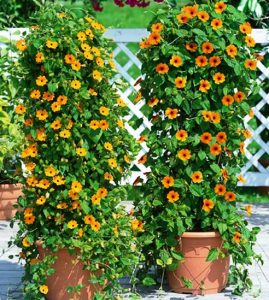
- Black Eyed Susan Vine (Thunbergia alata) is a short vine that grows well in a container. The silver dollar-sized yellow and orange flowers have a dark center, resembling black eyed Susans. You can often find the plants sold in hanging baskets. While they do well in small containers, put into a large container or transplanting into the ground encourages this vine to a really impressive size.
3 Cana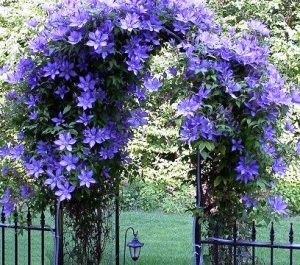 ry Creeper (Tropaeolum peregrinum) is a late season bloomer, starting in July and going through October. Its yellow inch across flowers resemble feathery birds. The foliage is very attractive, with deeply divided palm-shaped leaves. A vigorous grower, but like its nasturtium cousins, it needs something to climb up like a fence or deck railings. It also looks good simply scrambling through other plants.
ry Creeper (Tropaeolum peregrinum) is a late season bloomer, starting in July and going through October. Its yellow inch across flowers resemble feathery birds. The foliage is very attractive, with deeply divided palm-shaped leaves. A vigorous grower, but like its nasturtium cousins, it needs something to climb up like a fence or deck railings. It also looks good simply scrambling through other plants.
- Climbing Snapdragon (Asarina) Although sharing a name and with remarkably
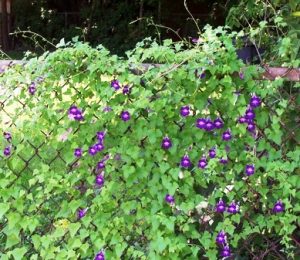 similar flowers, this climber is not a true snapdragon. The free-flowering vine is great in containers and spilling over walls. The vines will twine around strings and trellises and can be cut back if flowering fades. Climbing snapdragons can even be grown as houseplants. Flowers come in red, pink, lavender, and blue with speckled white chins.
similar flowers, this climber is not a true snapdragon. The free-flowering vine is great in containers and spilling over walls. The vines will twine around strings and trellises and can be cut back if flowering fades. Climbing snapdragons can even be grown as houseplants. Flowers come in red, pink, lavender, and blue with speckled white chins. - Cup and
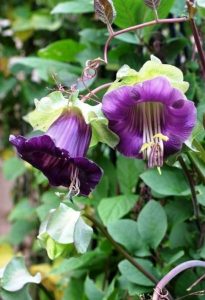 Saucer Vine (Cobaea scandens) These unusual looking flowers are sweetly scented. With delicate tendrils the vines gently attach themselves to supports. The actual flower, in lavenders and white, is the “cup”, surrounded by a “saucer” or collar of green calyx. Cup and Saucer vines take a while to start blooming, so it helps to start them early, indoors. For some reason, the flat seeds germinate better when planted on their edges. This makes them less prone to rot.
Saucer Vine (Cobaea scandens) These unusual looking flowers are sweetly scented. With delicate tendrils the vines gently attach themselves to supports. The actual flower, in lavenders and white, is the “cup”, surrounded by a “saucer” or collar of green calyx. Cup and Saucer vines take a while to start blooming, so it helps to start them early, indoors. For some reason, the flat seeds germinate better when planted on their edges. This makes them less prone to rot. - Ornamental Gourd isn’t grown for its flowers, but for its seed pods or gourds. There are a good variety of gourds that grow ea
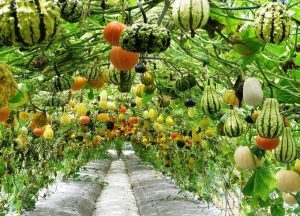 sily in just a few months. Many people let the vines sprawl on the ground, like squash, but if you are growing them for decoration, they will remain cleaner and less pest prone if you give them a structure to climb. A pergola or arbor looks especially whimsical with the vines growing across it, and the gourds dangling overhead. Many of varieties are easy to dry to be used as decorations and crafts, like a gourd birdhouse.
sily in just a few months. Many people let the vines sprawl on the ground, like squash, but if you are growing them for decoration, they will remain cleaner and less pest prone if you give them a structure to climb. A pergola or arbor looks especially whimsical with the vines growing across it, and the gourds dangling overhead. Many of varieties are easy to dry to be used as decorations and crafts, like a gourd birdhouse. -
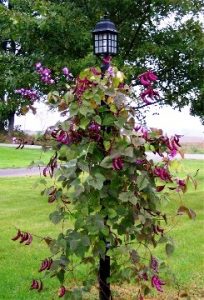 Purple Hyacinth Bean (Lablab purpureus) Every thing about this vine is riotous color. The heart shaped leaves have purple veining on the under-sides with stems that are in shades of deep purple. The profuse blooms are a rich lavender and the glossy bean pods are a day-glow purple. At one time this plant was an important foraged food source, but now it mostly is grown as an ornamental. The vines grow quickly and start flowering early with gusto. Flowers taper off, as the pods begin to form, but the plants remain attractive and continue spiraling upward.
Purple Hyacinth Bean (Lablab purpureus) Every thing about this vine is riotous color. The heart shaped leaves have purple veining on the under-sides with stems that are in shades of deep purple. The profuse blooms are a rich lavender and the glossy bean pods are a day-glow purple. At one time this plant was an important foraged food source, but now it mostly is grown as an ornamental. The vines grow quickly and start flowering early with gusto. Flowers taper off, as the pods begin to form, but the plants remain attractive and continue spiraling upward. - Scarlet Runner Bean (Phaseolus coccineus)
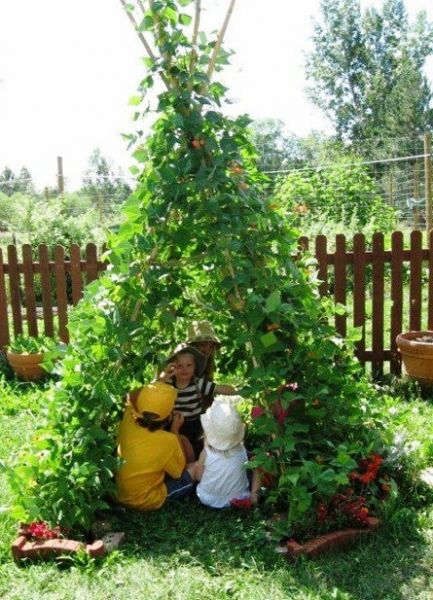 makes a nice eating bean when harvested young. However, as there are better-tasting beans, this variety is grown mainly for its beautiful flowers and showy bean pods. Once you try this plant in the garden you will understand why it’s earned its strong reputation as a popular flowering show vine.
makes a nice eating bean when harvested young. However, as there are better-tasting beans, this variety is grown mainly for its beautiful flowers and showy bean pods. Once you try this plant in the garden you will understand why it’s earned its strong reputation as a popular flowering show vine.
The vines can get long and heavy very quickly, so they must be provided a strong support. Although Scarlet Runner is commonly available, there are many other runner beans available in shades of red, pink, white, and combinations of colors. ‘Painted Lady’ has a soft red and white flower and the vines can tolerate heat better than most runner beans. ‘Moonlight’ is a pure white flower that produces one of the better-tasting, stringless runner bean pods.
- Sweet Pea (Lathyrus odoratus) vines look deceptively fragile. However, they are
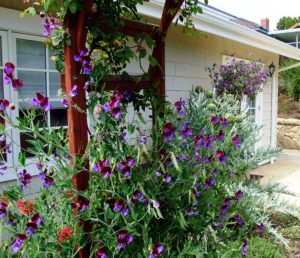 tough little vines that favor the cooler temperatures of spring and fall in the mountains. The flowers are known for their heavy, sweet fragrance, but not all new cultivars are heavily scented. For specific details be sure to read the plant tag before purchasing.
tough little vines that favor the cooler temperatures of spring and fall in the mountains. The flowers are known for their heavy, sweet fragrance, but not all new cultivars are heavily scented. For specific details be sure to read the plant tag before purchasing.
Sweet peas make great cut flowers, and the more they’re cut, the longer the vines bloom. My favorite way to use sweet peas is in my vegetable garden planted with my pole beans. Their blossoms entice bees and other pollinating insects into the garden, while adding their lovely colors and delicate fragrance.
Until next week, I’ll see you in the garden center.
Ken Lain can be found throughout the week at Watters Garden Center, 1815 W. Iron Springs Rd in Prescott, or contacted through his web site at www.wattersgardencenter.com or Facebook page www.facebook.com/WattersGardenCenter


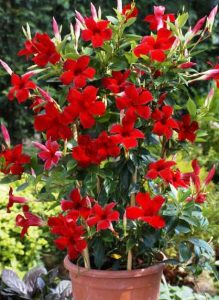
Vines are some of my favorite types of plants. Thanks for the info!
#3 Canary Creeper – That looks like a Clematis, not a Canary Creeper.